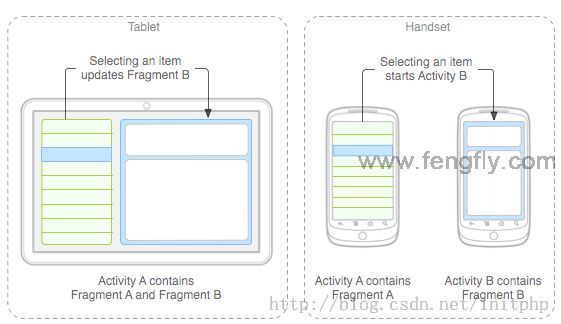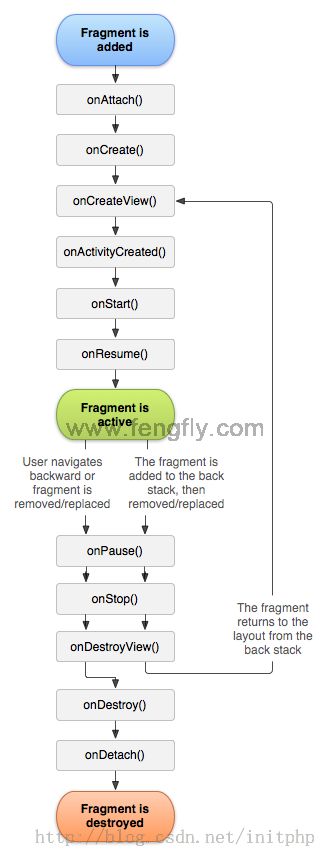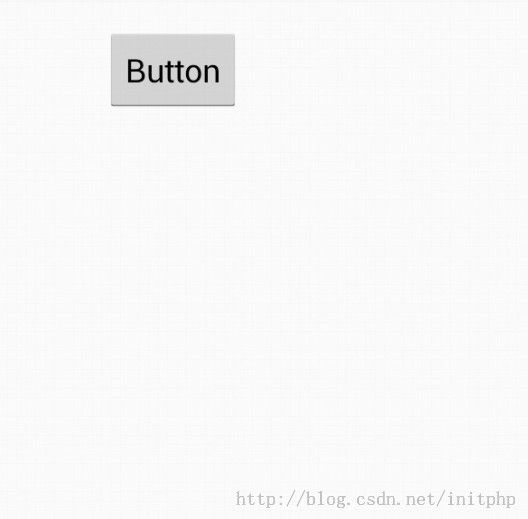安卓开发25:碎片 Fragment使用
Fragment说明
为了解决不同屏幕分辩率的动态和灵活UI设计。大屏幕如平板小屏幕如手机,平板电脑的设计使得其有更多的空间来放更多的UI组件,而多出来的空间存放UI使其会产生更多的交互,从而诞生了fragment。fragments 的设计不需要你来亲自管理view hierarchy 的复杂变化,通过将Activity 的布局分散到frament 中,可以在运行时修改activity 的外观,并且由activity 管理的back stack 中保存些变化。

生命周期:

1.onAttach() 当Fragment附加到Activity上调用。
2.onCreate() Fragment初始化操作
3.onCreateView() 用于首次绘制用户界面的回调方法,必须返回要创建的Fragments 视图UI。假如你不希望提供Fragments 用户界面则可以返回NULL。
4.onActivityCreated() 父Activity和Fragment的UI都被完全创建完后调用。
5.onDestoryView() Fragment的UI被分离时调用。
6.onDatch() Fragment从父Activity身上分离的时候调用。
7.onPause() 当用户离开这个Fragments 的时候调用,这时你要提交任何应该持久的变化,因为用户可能不会回来。
通过XML布局方式将Fragment放进Activity中
MainActivity
package com.example.test.com;
import android.app.Activity;
import android.os.Bundle;
import android.view.Window;
public class MainActivity extends Activity {
@Override
protected void onCreate(Bundle savedInstanceState) {
super.onCreate(savedInstanceState);
requestWindowFeature(Window.FEATURE_NO_TITLE);
setContentView(R.layout.main);
}
}
main.xml
<RelativeLayout xmlns:android="http://schemas.android.com/apk/res/android"
android:layout_width="700dp"
android:layout_height="300dp"
android:orientation="horizontal"
android:padding="10dp" >
<!-- 通过name指定 TestFragment -->
<fragment
android:id="@+id/fragment1"
android:name="com.example.test.com.TestFragment"
android:layout_width="wrap_content"
android:layout_height="wrap_content"
android:layout_marginBottom="52dp"/>
</RelativeLayout>
TestFragment
package com.example.test.com;
import android.app.Fragment;
import android.os.Bundle;
import android.view.LayoutInflater;
import android.view.View;
import android.view.ViewGroup;
/**
* 一个测试的Fragment
* @author zhuli.zhul
* @date 2013 2013-8-23 下午6:44:22
*/
public class TestFragment extends Fragment {
/**
* 显示页面
*/
@Override
public View onCreateView(LayoutInflater inflater, ViewGroup container, Bundle savedInstanceState) {
super.onCreateView(inflater, container, savedInstanceState);
return inflater.inflate(R.layout.test_f, container, false); //指定test_f layout
}
}
test_f.xml
<RelativeLayout xmlns:android="http://schemas.android.com/apk/res/android"
android:layout_width="700dp"
android:layout_height="300dp"
android:orientation="horizontal"
android:padding="10dp" >
<Button
android:id="@+id/button1"
android:layout_width="wrap_content"
android:layout_height="wrap_content"
android:layout_alignParentLeft="true"
android:layout_centerVertical="true"
android:layout_marginLeft="148dp"
android:text="Button" />
</RelativeLayout>

说明:
使用这种xml中指定Fragment的方法,有一种缺陷就是不能再Java代码中动态修改Fragment。下面我们会有一种通过Java代码动态控制Fragment的简单例子。
动态添加和控制Fragment
MainActivity
package com.example.test.com;
import android.app.Activity;
import android.app.FragmentManager;
import android.app.FragmentTransaction;
import android.os.Bundle;
import android.view.Window;
public class MainActivity extends Activity {
@Override
protected void onCreate(Bundle savedInstanceState) {
super.onCreate(savedInstanceState);
requestWindowFeature(Window.FEATURE_NO_TITLE);
setContentView(R.layout.main);
//通过fragmentManager 就可以动态新增一个Fragment
FragmentManager fragmentManager = getFragmentManager();
FragmentTransaction fTransaction = fragmentManager.beginTransaction();
fTransaction.add(R.id.frame, new TestFragment()); //新增
//Fragment fragment = fragmentManager.findFragmentById(R.id.frame); //通过id查找
//fTransaction.remove(fragment); //删除
//fTransaction.replace(R.id.frame, new TestFragment()); //替换
fTransaction.commit(); //提交
}
}
main.xml
<RelativeLayout xmlns:android="http://schemas.android.com/apk/res/android"
android:layout_width="700dp"
android:layout_height="300dp"
android:orientation="horizontal"
android:padding="10dp" >
<!-- 这个是可以动态修改的FrameLayout -->
<FrameLayout
android:id="@+id/frame"
android:layout_width="wrap_content"
android:layout_height="wrap_content"
android:layout_alignParentLeft="true"
android:layout_alignParentTop="true"
android:layout_marginLeft="106dp"
android:layout_marginTop="92dp" >
</FrameLayout>
</RelativeLayout>
TestFragment
package com.example.test.com;
import android.app.Fragment;
import android.os.Bundle;
import android.view.LayoutInflater;
import android.view.View;
import android.view.ViewGroup;
/**
* 一个测试的Fragment
* @author zhuli.zhul
* @date 2013 2013-8-23 下午6:44:22
*/
public class TestFragment extends Fragment {
/**
* 显示页面
*/
@Override
public View onCreateView(LayoutInflater inflater, ViewGroup container, Bundle savedInstanceState) {
super.onCreateView(inflater, container, savedInstanceState);
return inflater.inflate(R.layout.test_f, container, false); //指定test_f layout
}
}
test_f.xml
<RelativeLayout xmlns:android="http://schemas.android.com/apk/res/android"
android:layout_width="700dp"
android:layout_height="300dp"
android:orientation="horizontal"
android:padding="10dp" >
<Button
android:id="@+id/button1"
android:layout_width="wrap_content"
android:layout_height="wrap_content"
android:layout_alignParentLeft="true"
android:layout_centerVertical="true"
android:layout_marginLeft="148dp"
android:text="Button2" />
</RelativeLayout>
说明:
效果是一样的,但是可以动态添加删除以及隐藏显示等操作。